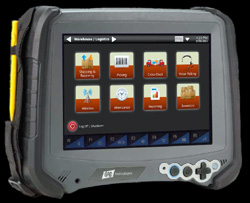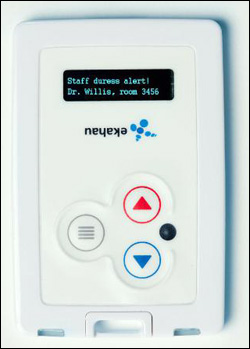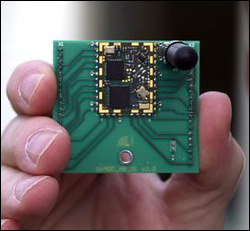Oct 17, 2013The following are news announcements made during the past week by the following organizations: DAP Technologies; Omni-ID; Ekahau; STEL Solutions; RFID in Europe; Star Systems International; Star RFID Co.; OmniAir Consortium; IBM; and Semtech.
DAP Technologies, Omni-ID Partner on Rugged Tablet With Active and Passive RFID Readers
DAP Technologies, a unit of Roper Industries, and Omni-ID, have introduced a new rugged tablet that can incorporate both active and passive RFID reader capabilities into a single, integrated form. The DAP M9010 rugged tablet can include either a reader for ultrahigh-frequency (UHF) passive tags; a 433 MHz active reader designed by Omni-ID, based on its proprietary gateway technology and intended for use with Omni-ID's ProView tags (which combine active RFID and an EPC Gen 2 passive inlay); or both interrogators. The combination of both the UHF and active RFID technologies in a single tablet lets customers carry only one mobile device to track assets, collect information, synchronize systems, report data, and receive and respond to messages. The UHF reader has a read range of 7 to 20 feet (2.1 to 6.1 meters) depending on tag type, and a write range that is 70 percent of the read range for TransCore's eGo Plus and eGo passive tags (TransCore is one of DAP's sister companies), or tags compliant with the EPC Gen 2 and ISO 18000-6C standards, and 100 percent of the read range for TransCore's IT2000 (Allegro) tag. The tablet also offers wireless USB connectivity that can be used to stream data, voice and HD video at high speeds, and a Qualcomm Gobi 3000 embedded module so the M9010 can connect to multiple broadband carriers for mobile Internet. According to the companies, the M9010 features a Windows-based application for easy integration (Windows 7), an easy-to-carry or -mount rugged form factor for multipurpose use, a sunlight viewable touchscreen, bar-code reader capability and optimized power management for extended use without docking. It is also IP 67-rated (signifying that it is dustproof and waterproof), able to withstand submersion in water for brief periods, and intrinsically safe.
Flagler Hospital Improves Caregiver Communications With Ekahau's RFID-over-Wi-Fi
Ekahau has announced that Flagler Hospital has implemented its RFID-over-Wi-Fi real-time location system (RTLS) within the hospital's behavioral-health unit, to help improve caregiver communications and streamline workflows The RTLS solution, consisting of Ekahau's Wi-Fi-based RFID tags, infrared (IR) beacons to make location data more granular and Ekahau Vision software, provides what Ekahau refers to as proximity-based geo-messaging to improve coordination of patient care and communications between nurses and physicians. Flagler's caregivers wear Ekahau's battery-powered B4 RFID badges during their shifts; if assistance is needed, a worker presses one of two badge buttons. The Ekahau Vision software captures and interprets that person's location and other information, and then transmits that location and other emergency details to nearby coworkers. The calls are displayed on the badges' light-emitting diodes (LED) as text messages. The solution eliminates the need for map lookups, according to Ekahau, and caregivers can also search for other employees on real-time, Web-based floor plans, using the
Ekahau Vision software. Other health-care organizations that are using the company's RFID-over-Wi-Fi RTLS solution include Josef-Ecker-Stift Neuwied, a senior-citizens home and nursing facility (see RFID News Roundup: German Senior Citizens Home Implements Ekahau Wi-Fi RTLS).
Spanish Integrator Unveils NFC-enabled Laundry-Tracking Service
Spanish technology integrator STEL Solutions has announced a service—known as STEL Laundry—that uses Near Field Communication (NFC) RFID tags attached to garments to help track and manage inventory, as well as reduce handling errors when items are sent for cleaning. The service is designed for nursing homes and other companies that handle large volumes of garments, such as industrial laundries. According to Jesus Mora, STEL Solutions' founder and CEO, the service combines NFC RFID technology, cloud computing and an application that can be downloaded on a mobile phone. "The aim of STEL Laundry is to save time and money in clothing classification tasks in geriatrics and other scenarios," Mora explains. The service employs NFC tags provided by Tagsys, as well as NFC-compatible Android smartphones, and also works with desktop NFC RFID readers from Tagsys and Feig Electronic. The reusable passive RFID tags are about the size of a button, STEL Solutions reports, and are capable of withstanding laundry processes.
RFID in Europe Launches RFID&U Consumer Web Site
RFID in Europe, a nonprofit international association aimed at promoting the use of radio frequency identification and related technology solutions by small and midsize organizations throughout the continent, has launched the RFID&U Web site. The initiative, sponsored by the retail and RFID industries, is designed to raise public awareness about the many ways in which RFID offers consumers and the public convenience and other advantages by presenting the technology—and its many uses—in a simple, non-technical manner. RFID&U references the European Commission's RFID recommendations by providing information regarding the RFID emblem (see EU Group Seeks Collaboration Among RFID Standards) and the RFID Privacy Impact Assessment (PIA) Framework (see GS1 Releases Privacy-Assessment Tool for RFID Users). Additionally, says Trevor Peirce, RFID in Europe's public policy officer, the initiative is designed to encourage wider participation in expanding upon the information it makes available, and in developing the user experience. "We wish to address all uses of RFID which are public/consumer-facing," he says. "It is not only the breadth we wish to expand upon, but also the depth of content, with regular updates with new stories to tell." RFID&U intends to offer different language versions of the information, and there are provisional plans to make RFID&U's messages more dynamic, in an attempt to appeal to a wider cross-section of the public by exploiting mobile platforms. According to Peirce, RFID in Europe is currently engaged with RFID&U's consortium partners to promote the initiative. "It is our goal that RFID&U should become a visible link on all RFID user Web sites where these users present or offer RFID-related products or services which interface with the public/consumer," Peirce states. "Broad stakeholder participation in RFID&U is actively sought."
Star Systems' RFID Decals Receive Certification from OmniAir
Star Systems International, an RFID hardware provider and value-added distributor, and Star RFID Co., a Thailand-based RFID tag manufacturer, have announced today that their Venus and Aries EPC Gen 2 ultrahigh-frequency (UHF) RFID decals have been certified by OmniAir Certification Services (OCS), the test affiliate of the OmniAir Consortium. Both the consortium and OCS are nonprofit standards organizations working to advance the deployment of interoperable advanced transportation technologies, and to oversee testing and certification services for ISO 18000-6C (EPC Gen 2) passive UHF RFID tags and readers for toll-collection applications (see Efforts to Aid Adoption of ISO 18000-6C RFID for Toll Collection Move Forward). According to Star Systems International and Star-RFID, the certification assures the interoperability of the Venus windshield and Aries headlamp decals with readers and toll facilities using equipment complying with requirements as defined by the 6C Toll Operators Committee, based on the ISO 18000-6C RFID protocol. Other companies that have received OmniAir certification include Confidex (see Confidex's RFID Windshield Label Receives Interoperability Certifications from OmniAir Consortium).
IBM, Semtech Partner to Give the Internet of Things Greater Distance
IBM and Semtech, a supplier of analog and mixed-signal semiconductors, have announced a joint initiative combining IBM software and Semtech hardware. The solution enables the creation of a wireless sensor network capable of transmitting data up to a distance of 9 miles (15 kilometers). The system is easy to program and use, the companies say, and is designed to advance the Internet of Things. The joint solution comprises IBM's Mote Runner software and Semtech's SX127x chips. The Mote Runner software, unveiled in 2010 (see RFID News Roundup: IBM Intros Wireless Sensor Development Kit, Teams With MEMSIC), is designed to make wireless sensor networks easier to program and exploit, and to connect sensor and actuator motes within a wireless sensor network. Motes—also known as wireless sensor nodes—gather sensory information, such as temperature, movement or light, and communicate that data across a network of wireless sensors. According to IBM and Semtech, the Mote Runner platform is now available on the Semtech SX1272 chip (a battery-powered UHF [860 to 1,000 MHz] transceiver IC with a built-in temperature sensor), to create a system capable of covering a range of 9 miles in a semi-rural environment and up to 3 miles within dense urban environments. For comparison, the two companies note, the maximum distance today of a smart-meter transceiver in Europe, utilizing frequency-shift keying (FSK) modulation, is between 1 and 2 kilometers (0.6 and 1.2 miles). The IBM and Semtech sensor platform utilizes Semtech's new LoRa (long-range) modulation technology to enable drastic range improvements over alternative modulation methods, the firms report, and the additional range will eliminate the need for repeaters, significantly simplifying the system design and lowering the total cost of deployment. The new sensors, Semtech and IBM explain, will utilize a star network architecture, with each gateway capable of handling millions of transactions daily, thereby making it easy to deploy any number of applications, ranging from smart metering to remotely monitoring train tracks. The SX1272 is available now for sampling, and can also be purchased in production quantities.




